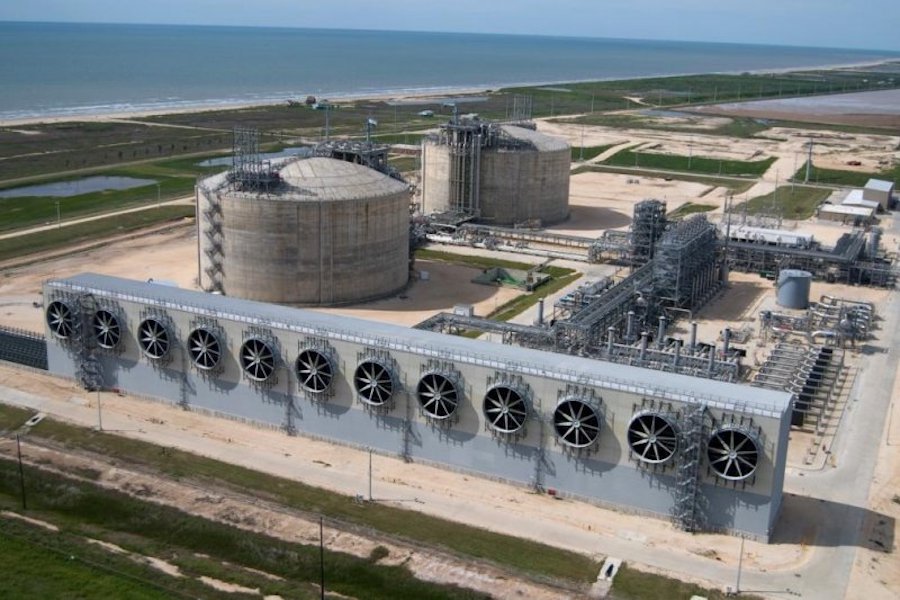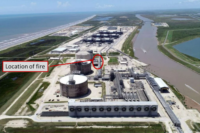Energy Construction
New Report Details Triggers of June Blast at Still Closed Texas LNG

Shutdown of the explosion-damaged Freeport LNG liquefied natural gas export plant in Texas will continue into December, the firm said Nov. 18, confirming market speculation that repairs, needed process changes and approvals had not reached the point where it could reopen this month as it had recently predicted.
Facility officials hired Kiewit Corp. to manage site reconstruction and restart of the plant, the second largest of its type in the U.S., which had exported 15 million tons per year of liquid gas, with most supply going to Europe since the Ukraine war began. Sector consultant Rystad Energy says shipments from Freeport had risen 44% since the invasion, with the facility supplying 10% of the continent.
In a statement, plant operator Freeport LNG said that of Nov. 14, reconstruction work necessary to start initial operations, including use of all three iquefaction trains, two LNG storage tanks and one dock, was about 90% complete, "with all reconstruction work anticipated to be completed by the end of November."
The company did not disclose or respond to queries on the nature or scope of reconstruction work but said it had submitted to regulators a remedial work plan to restart initial operations by mid-December, with full production anticipated to start in March 2023.
Blast 'Root Cause' Details Released
A key federal oversight agency—the U.S. Pipeline and Hazardous Materials Safety Administration—released on Nov. 15 an accident report called the Root Cause Failure Analysis, filed by the facility earlier in November, with new detail on factors that contributed to the explosion. The highly redacted report, by Houston risk and fire consultant IFO Group, cited a lack of pipeline safety valve testing and locking procedures to prevent unauthorized operation—and human error.
The firm “was unable to identify any other plausible explanation than human error” that left a pipeline safety valve closed after valve testing conducted on April 26.
Operators at Freeport LNG were trained to assist with valve testing by observing more experienced operators and then expected to oversee contractor-led work with no further training and without a written procedure or checklist and no required seal auditing during operation, the IFO Group report said.
Without overpressure protection of the safety valve, a segment of pipe containing cryogenic LNG started heating up early in June and expanded, which resulted in a boiling liquid and vapor explosion that ruptured it.
Line overpressurization caused the pipe “to fail catastrophically and cause a cascading series of multiple piping failures within the pipe rack,” said IFO Group, which resulted in “release of mixed-phase LNG into the pipe rack and surrounding area.”
Control room operators were unaware that the warming LNG within the pipe was exerting excessive pressure until after the incident, said the report, noting that “the line was inadequately safeguarded with only PSV to protect it from excessive pressure.”
Overtime 'Patterns of Concern'
While the pipe experienced unusual movement caused by thermal expansion from increased pressure, “no one at the site recognized the cause,” the probers said. “The facility had a long-standing practice of calling in operators on overtime to provide staffing for [safety valve] inspections and other related activities,” said their report, noting that inspectors who reviewed hours worked, saw “some clear patterns of concern.”
In days and weeks before the incident, 23% of staff worked between 110% and 119% of their scheduled hours, with 54% working more than 120% of that timeframe and 20% working more than 130%. “During the period assessed, each shift averaged 12 or more hours per shift and operators generally worked 84 hours per pay period excluding unscheduled overtime,” IFO said.
The consultant used federally sanctioned National Transportation Safety Board and NASA methods to assess operator fatigue, concluding “it was a probable contributing factor in the cause of this incident.”
IFO Group also pointed to contact between methane and damaged electrical conduits, which resulted in a vapor cloud explosion and a small secondary pool fire. “There was also a short-term release of vaporizing LNG from damaged 3” piping that failed to ignite and was suppressed by firewater master streams deployed by the emergency responders,” it said.
The new report also noted that the control room console does not have an alarm to warn operators if temperatures exceed parameters. Operators told IFO Group that there were alarms constantly indicating concerns on equipment that was taken out of service years ago—“apparently resulting in alarm fatigue.” But instrumentation used for leak detection had “no audible or visible alarms available to warn operators.”
Freeport LNG said in a statement that it is implementing the consultant’s recommendations, including improved protective safety valve testing and updated control room alerts of valve positions or temperature readings that indicate isolation of LNG in a piping segment.
The company also has hired a second consultant it did not name to perform a full review of its operating procedures for LNG storage and transfer, maintenance and inspection and training programs. It also plans to increase site staffing by more than 30% to reduce overtime and boost training and quality assurance.
"We are committed to moving forward with an uncompromising safety focus and enhanced operational processes," said Michael Smith, Freeport LNG chairman and CEO.





